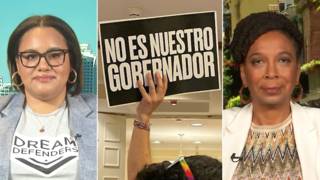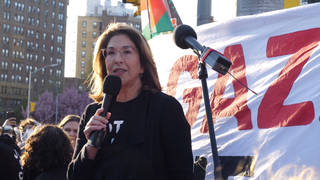
Related
Sociology Professor Joe Feagin of the University of Florida, speaking at a Public Education Network conference, talks about racism and the denial of racism in white society. Feagin cites surveys that show that a large percentage of white Americans have racist views of Black people, and surveys showing that the majority of African Americans face discrimination. Feagin goes on to show the imbalance between white and Black people in positions of influence and power. Feagin calls for an examination and recognition of racism in white society, and he says that change must come, as demographers predict whites will become a minority in many American cities.
Segment Subjects: Education, Race, Racism, public schools.
Transcript
AMY GOODMAN: Welcome to this special edition of Democracy Now! I’m Amy Goodman.
Just a few weeks ago, I went to a very interesting conference in Washington, D.C., that was sponsored by the Public Education Network. This is a group that supports community-based organizations in uniting and engaging their communities in building systems of public schools that result in high achievement for every child. The whole idea is that these community-based groups are the best mechanism for creating broad citizen support for public education, and that public education is fundamental to a democratic, civil and prosperous society.
Well, the topic of the conference was “Education and Race,” and today we wanted to share some of it with you. In just a little while, we’re going to talk with three teachers: one, a Latina teacher from South Central, Los Angeles; another, a Philadelphia elementary school teacher, she’s Asian American and an activist, as well; and we’ll be joined by an African American professor from Mount Holyoke College whose specialty is the psychology of race.
But right now we’re going to turn to professor Joe Feagin. He’s a graduate research professor in sociology at the University of Florida, and among his books is Living with Racism: The Black Middle-Class Experience. He gave the opening remarks at the Public Education Network’s conference.
JOE FEAGIN: First, let me say that I’m very pleased to be here, and I think it is an — you should honor yourselves for dealing with this crucial topic of education and race. There are far too many of us, particularly those of us who are white in leadership positions in this country, who are unwilling to face this question of education and race. We tend to run from it. Let me also say that I admire your fine work in pressing for more support and resources across this country for public education. No country can long survive without focusing strongly and supporting strongly its public education system. And I think your efforts in this regard are much needed in these troubled times for education in this country. So I admire your work. And it’s in that spirit that I come to you to talk today.
As all of you know, there’s much talk of educational reform across this country. And this reform focuses on things like privatization and charter schools. And some of it focuses on what’s, oddly enough, called the three Rs — I never quite understood that — reading, writing and arithmetic, that our children need more emphasis on these matters. And there are certainly many different kinds of proposals for enhancing our children’s learning and their abilities in the area of reading, writing and arithmetic. This attention is certainly much needed in this country.
But today I want to talk about a fourth R. This fourth R is one that we don’t talk about. At least those of us who are white rarely talk about it. This fourth R is racism. And the racism I want to focus on today is white racism. Clearly, white racism in this country today, 1996, is not seen as a problem by the political, economic or educational leadership — at least the white leadership — of the United States. White racism is certainly not seen as a problem by the general white public. Indeed, most whites in this country are running as fast as they can away from a candid, honest, open discussion of race and racism in the United States. I sometimes think if the whites who do not want to face the issue of racism were individuals with psychological problems of denying reality, we would suggest massive treatment for them. But today most whites simply deny the reality of racism in the United States. This is a serious problem.
Today I want to look at this question of racism together with you. I want to work with you to help you better understand what racism is and what it’s doing to the nation. Let me say I’m not trying to accuse anyone of being racist. I will simply demonstrate that all of us who have grown up and live in a racist society can either partake of racism and not fight it or we partake of racism and fight it. We really have no other choices. We can be passive in the face of continuing racism in our society, or we can stand up and fight against it. If we’re passive, we let racism define who we are as white Americans and other Americans. If we stand up and fight against it, we admit there is a racist society around us, that we have partaken of it in the past, but in the future we’re going to do something about it. We’re not going to let racism define whom we are as human beings and as Americans.
I’ve been researching in this area for 32 years. I’m a native white Southerner, as you can see and probably hear from a little bit of my drawl and accent here and there. Everything I say, every interpretation I make goes against my own vested group’s interest. Every conclusion I’ve come to is on the basis of research and data, and I wish the data were not so.
In 1992, the Anti-Defamation League did a nationwide, random sample opinion survey of white Americans, gave them a list of eight racist stereotypes of African Americans. Eight stereotypes. Black people are less intelligent than whites, prefer welfare to other racial groups, and so forth. Three-quarters, 76%, of whites admitted to the pollster, a stranger, that they thought one or more of those racist stereotypes were correct. Seventy-six percent of white Americans admitted they were racist in their thinking about African Americans. Admitted it, to a stranger. And I suspect if we had interviewed them at the same time and asked them, “Do you consider yourself a racist?” almost all of them would have said no. Fifty-five percent agreed with two or more of the racist stereotypes, and 30% of the sample agreed with most of the racist stereotypes presented to them by this stranger, a pollster. Now, you plot that out in terms of the population. There are about 150 million adult white Americans. They only poll adults. If you extrapolate from the poll to the 150 million adult white Americans, you can see that over 100 million white Americans are probably still racist in their thinking, and 45 million, 30%, of adult white Americans are extremely racist in their thinking. Forty-five million adult white Americans are very racist in their thinking. And there are only 35 million Black men, women and children in the United States. The probability of a Black person out in the white world hitting a very racist white person, that probability is quite high. Many other surveys show this same pattern. I can give them to you if you want.
Some more facts. It would be bad enough if racism were just a matter of white attitudes and stereotypes, but much more serious than the attitudes is the fact we act on them. Discrimination against African Americans and other people of color is extremely widespread in 1996 in the United States, even though our mass media give it little or no attention except when a major incident like the Texaco incident forces on the mass media.
For example, a researcher, a fellow sociologist, in 1994 in Los Angeles surveyed 1,000 African American employees in the Los Angeles area. Sixty percent of them said they had faced workplace discrimination in the last year — 60% — such as being refused a job because of their racial group or refused a promotion because of their racial group. And the findings of this study get worse because more than 90% of the best-educated African Americans reported employment discrimination. Ninety percent of those with graduate degrees reported having faced racial discrimination in the last year.
Another piece of evidence. In a 1989 federal survey using 3,800 test audits, sending Black and white auditors — they also sent in Latino auditors — Black, white, Latino auditors into rental and home-buying situations to see if the white landlords and realtors would discriminate against the Black tester, the Latino tester relative to the white tester. That survey, using testers, Black and white and Latino testers, took place in 25 metropolitan areas, and they did 3,800 test audits. Fifty percent of time, the Black home seekers faced discriminatory treatment — 50% of time, the Black renters faced discriminatory treatment at the hands of white landlords, and 59% of the time, Black home buyers faced discrimination at the hands of real estate salespeople. That was 1989. We say, “Well, we’ve come a long way — right? — since 1989.”
I was looking last week at three 1996 audit studies in housing, in Fresno, California; Montgomery, Alabama; and New Orleans, Louisiana. They also sent Black and white testers out into the field to look at housing discrimination, and the rate of discrimination, guess what, was 70 to 80% in all three states. The Black tester, relative to the white partner with a similar story and a similar dress, the Black partner suffered discrimination 70 to 80% of the time. “Sorry, the apartment’s just been sold,” or just been rented. Just been rented. The white tested comes 20 minutes later, “Oh, yes. Let me show you that apartment.” Now, these were all in predominantly white areas, so African Americans seeking rental housing in predominantly white areas will face discrimination at a very high rate. Or, to turn it around, 70 to 80 percent of whites with housing to rent will discriminate if you give them a chance to do it. Seventy to 80% of white Americans will discriminate in housing if given the chance.
Now, the earlier study also had Latinos. The rate for dark skin Latinos was about the same as for African Americans. Discrimination is massive in this country. It happens tens of millions of time just in housing alone. We have tens of million of cases of discrimination against people of color in this country each year by white landlords and real estate people. And that civil rights law, the housing law, is largely unenforced.
Some of you may be familiar with the recent ACORN study in New York City, where they sent in testers, trained testers, posing as parents to the elementary schools in half of New York’s districts. And the white testers got much better treatment than the Black testers or the Latino testers. The white testers were able to speak with an educator much more often than the Black and Latino testers. And whites were two-and-a-half times more likely to get a school tour than testers of color. White testers got much more information than testers of color.
Professor Ian Ayres at Yale Law School has been doing studies in car dealerships. He set up white, Black, male and female testers to go into 90 car dealerships in Chicago recently. They did 180 transactions, found discrimination against women and Blacks in making deals in car dealerships. White women had to pay 40% higher markups on the same cars than white men. Black men had to pay 100% higher markups than were quoted to the white men. And Black women had to pay 300% markups compared to the white male testers.
And then, what was it? Monday we learned that the top corporate executives in this country, when they think they’re off the record — in this case, at Texaco — talk about “nigger” this and “nigger” that and black jellybeans clumping together in the company and about destroying records that the six Black employees who are suing the company need to prove discrimination at the company. That was Monday. And these, of course, were not the, quote, “rednecks” that the father in the first account is blaming discrimination on. These are our most influential corporate leaders in the United States of America.
The bottom line, of course, is the fact that we white men still control most of the most powerful positions in the United States. I’m always amazed at public discussions of affirmative action which don’t point this out. But a fellow social scientist, Tom Dye at Florida State, surveyed the 7,314 most powerful positions in U.S. society — 7,314 law partners, major judges, key members of Congress, top corporate executives, you name it, 7,314 most powerful positions in the United States. Guess how many Black folks there are in those 7,314 positions. He found 20. Twenty. Now, 10% of 7,314 is 731. One percent is 73. Twenty is a lot smaller than 73. So, African Americans make up, what, a third, less than a third, something like that, of 1% — occupy about a third of 1% of the most powerful positions in the society. Guess how many white women were in these positions. Three hundred and eighteen. So, if you put all the people of color and all the white women together, they make up 5% of the most powerful positions in U.S. society. Five percent. Folks like me make up 95%. And that’s after nearly 30 years of affirmative action. The most effective affirmative action program in this country is the one that sees to it that people like me get these jobs. That’s the most effective affirmative action program in this country. Twenty African Americans and 318 white women after 30 years. Last time I looked, we didn’t have a single top corporate executive who is African American. We may have one now that I don’t know about, but I think it’s zero or one probably.
Today, racism clearly presents a huge challenge for our educational system, at all levels, from pre-schools to elementary schools to secondary schools and colleges. The three examples in the data I’ve given you, I think, show clearly that a significant part of the problem lies in education, and reeducation of whites and other Americans about the society’s racism and about our own racism. If we are to secure better futures for our children, whatever their racial or ethnic backgrounds, we must confront honestly and openly racist prejudices, racist discrimination, and the consequences of those prejudices and discrimination. Well, my main job was to kind of lay this problem for you, I think. But I want to suggest a few, if I may briefly, solutions.
AMY GOODMAN: You’re listening to professor Joe Feagin. His book is called Living with Racism. We’ll be back with him in just a minute.
[break]
AMY GOODMAN: You’re listening to Democracy Now! The Exception to the Rulers. I’m Amy Goodman, as we continue with Joe Feagin, a graduate research professor in sociology at the University of Florida and author of Living with Racism.
JOE FEAGIN: The solutions are fairly obvious. The guts and will to implement them are problems. First, we must enforce our civil rights laws in education, public accommodations, employment and housing. Law and order must be restored in regard to racial, ethnic and gender discrimination in this country. And clearly, educators, those of us in education, working in public education, have an obligation to push our leaders hard to enforce the anti-discrimination laws, the civil rights laws of this nation. For the most part, we do not enforce anti-discrimination laws, racial, ethnic or gender, in this country.
Secondly, education is obviously critical to any program to root out racism in this society. The longer the white denial of racism continues, the worse the problem will get. We in public education must work for educational solutions to white racism. We must develop better multicultural curricula, courses and programs, that not only deal with teaching children to respect differences and diversity, but also teach children to recognize and unlearn racism in their own thinking, feeling and actions. All children must be taught honestly about the racist history of this society and about the continuing prejudices and racist discrimination in the late 1990s. We need the same educational programs for adult white Americans, I would add.
Third, we must work against, as most of you have, the attack on public schools, which reflect a thinly veiled racist perspective among whites who fear truly integrated and multicultural education. This nation is not likely to long endure if privileged whites segregate themselves into private schools and gated communities. South Africa is a good example of that. You can create apartheid for a while, but it doesn’t last forever.
Fourth, we must deal with racism in ourselves. This may be the place to start, and it’s a tough and hard place I recognize. As Senator Bradley says, often he says, “I’m a recovering racist.” Those of us who were raised in a racist society did not choose to do so. We were born into it. We’ve either been born into it or immigrated into it. And we reside in a society which is still, in its society and its culture, quite racist. Racism is peddled to all of us on a regular basis in the mass media and by some of our friends and relatives. That world still has very serious problems of racism. As individuals, we must examine our own thinking, prejudices and racisms, our minds and hearts. And as one white antiracist put it — this is one of the people I interviewed, as well as Senator Bradley — “We must strive to be the best recovering racist we can be.”
Let me conclude by saying this. Change is coming to this society whether we like it or not. The future will definitely be more multicultural and multiracial than it is today. Those of you in public education know this is a fact. Today whites of European background are becoming the minority in all of our major cities. And certainly children of European American background are becoming the minority of most of our large public school systems. By the year 2005, white Americans will be the minority of the population in the state of California. They already are in parts of southern Florida, California and Texas. The estimates by the demographers are that by the year 2055, whites will be the minority of the population in the United States. By the year 2055, whites will be the minority of the population in the United States. By the year 2030, nationally, white children will be a minority of the schoolchildren in this country, within about 34 years.
In the United States, an antiracist, multicultural approach cuts to the heart of the democratic principles of liberty and justice. This nation can be proud of being founded on these principles, the recognition of human dignity and human worth. But if these principles are to become more than a pipe dream, the contributions and qualities of subordinated people of color must be recognized as equal in importance to whites, and the continuing oppression of people of color must be recognized and fully uprooted wherever it appears. I think today all Americans can benefit from an extricating of this nation from the roots of racism. Thank you.
AMY GOODMAN: That’s Joe Feagin, professor of sociology at the University of Florida. He opened the Public Education Network’s conference that took place just a few weeks ago in Washington, D.C.












Media Options